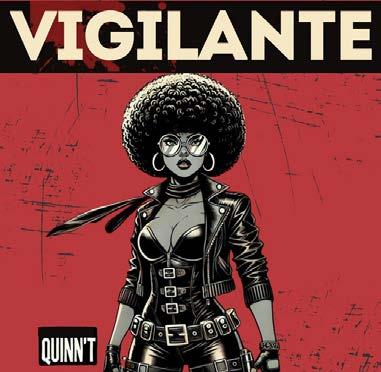
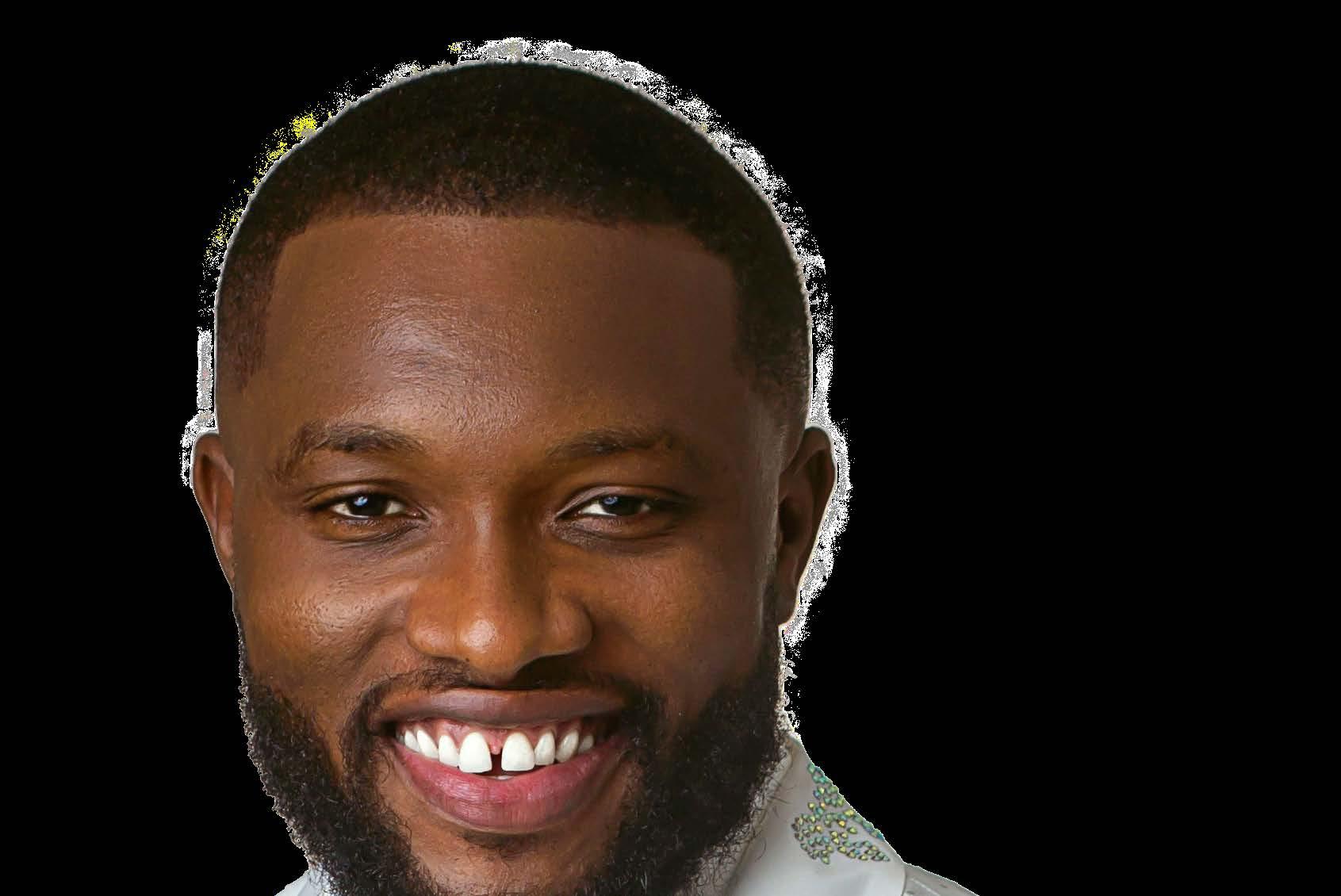









EPhoto: Kola Oshalusi @insignamedia Makeup: Zaron
mmanuel Ikubese wears multiple creative hats: he is an actor, director and a model. While they all have their different levels of difficulty, he says the most challenging is being a director because he has to seek out funding, build from scratch and tell his own stories. He also says that preparing himself not just to be a player in the industry, but as someone who also shapes what the industry will look like in the next five to ten years, requires a lot of work and that in itself is challenging. As for whether there are times when he wondered if he was on the right path, Ikubese admits that everyone has those times when they question their actions, wondering whether they are doing the right thing. For him, that’s where his faith in God comes in and his belief that he was called to do what he is doing. He makes a profound statement: “Just because you are called to do something doesn’t mean there won’t be resistance.” I find this statement to be very true.
Read Emmanuel Ikubese’s story on pages 8 to 10 of this issue.
While lotions or moisturisers help to keep the skin hydrated and soft, what happens when you run out of your usual product? In this week’s beauty page, we showcase alternatives to body lotions. Scroll to page 12 for this.
Downtown Confidential tells the story of someone who was caught in the act. I won’t give out too much about the story. Let’s just say it was very embarrassing. Scroll to page 15 to read this story.
As always, our movie review page reviews the latest movies. There is also a playlist for you to download some music. Let us know what you think.
Until next week, enjoy your read.


@onahluciaa + 2348033239132
AUSTYN OGANNAH PUBLISHER/EDITOR-IN-CHIEF
Executive Editor: Onah Nwachukwu @onahluciaa
Writer: Johnson Chukwueke
Design & Layout: Olaniyan John ‘Blake’ Digital Media: Oladimeji Balogun Consulting Art Director: Sunny Hughes ‘SunZA’



Soothe The Soul Mood-Boosting Habits For Grey-Sky Days 5 Alternatives to Lotions And Moisturisers X is for Chapter X Seeing the Unknown
WELLNESS
I Know What You Did Last Summer 8-10 15 16 14 REVIEW DOWNTOWN CONFIDENTIAL COVER


Emmanuel Ikubese Building a Legacy Through Stories Something Unholy

Boluwatife Adesina @bolugramm - Contributing Writer
Boluwatife Adesina is a media writer and the helmer of the Downtown Review page. He’s probably in a cinema near you.
Dorcas Akintoye @mila_dfa_ - Contributing Writer
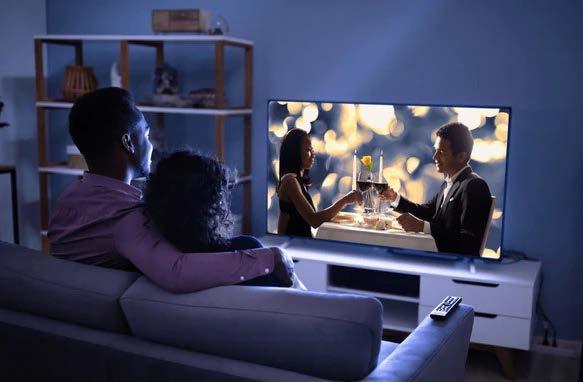




John Angel Fashioning Nollywood’s Boldest Looks Yet FEATURE @seguntheaktor



Dorcas Akintoye is a dedicated writer with more than 2 years prolific experience in writing articles ranging from food, entertainment, fashion and beauty. She has a National Diploma in Mass Communication from Kwara State Polytechnic, Ilorin. She loves writing, listening to music and playing scrabble. She is a highly-skilled, enthusiastic, selfmotivated professional writer.

Sally Chiwuzie @unshakable.is.a.state.of.mind - Contributing Writer
Sally Chiwuzie is a non-practising barrister who owns the brand #Unshakable. She is the author of Silent Symphonies, a fictional love story, and the creator of the podcast Chronicles of #Unshakable Truths.
@royaltylove2 @mahlako_dm What a fine man




BY DORCAS AKINTOYE
Red is one of those bold colours that instantly commands attention. Whether it’s a bright cherry red or a deep wine shade, wearing red can make you look and feel unstoppable. But because it’s such a strong colour, many people shy away from it, unsure of how to style it without doing too much. The good news is that you can wear red stylishly without looking over-the-top. The key is in how you pair it, the style you choose, and how you wear it confidently. In this article, we will explore six stylish and simple ways you can wear red and stand out in the best way possible.

START WITH A RED STATEMENT PIECE
If you’re new to wearing red or unsure about how to start, the easiest way to ease into it is by picking one red piece and building your outfit around it. A red blazer, a red pair of trousers, or a red handbag can instantly elevate your look without making it feel like too much. For example, pairing a red blazer with a white tank top and denim jeans makes for a chic yet effortless outfit. The idea is to let the red item be the star of your outfit while keeping everything else simple and neutral. This way, you’ll look stylish without feeling overwhelmed by the colour.

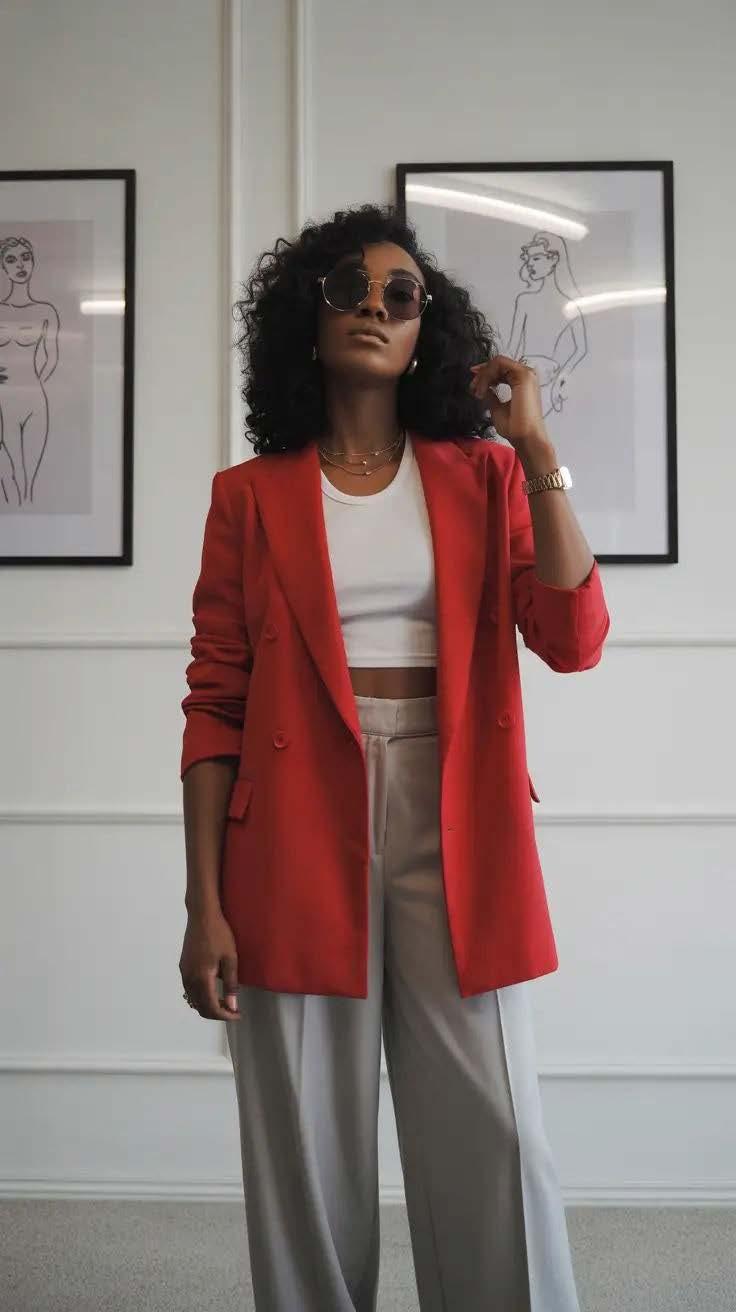
MIX RED WITH NEUTRALS
One of the most classic and foolproof ways to wear red is to mix it with neutral tones like black, white, beige, grey, or navy. Neutrals help tone down the boldness of red while still letting it pop. For instance, a red dress with a nude pair of heels or a red skirt paired with a black top gives off a balanced and classy vibe. When red is paired with neutral colours, it comes off polished, sophisticated, and well-put-together without looking too loud.

If you’re not ready to wear red clothing, you can still embrace the colour through your accessories. Think red shoes, red earrings, a red belt, or a red clutch. These small additions of red can bring life to an otherwise basic outfit.

GO FOR A RED MONOCHROME LOOK
Wearing different shades of red from head to toe can look very fashion-forward and chic when done right. The trick is to mix textures or slightly different tones so it doesn’t feel flat.

Another stylish way to wear red is to combine it with prints or patterns. Red pairs beautifully with prints like polka dots, animal prints, florals, or stripes. You can wear a red skirt with a leopard print blouse or a red blazer over a striped top and jeans.

One of the smartest styling tricks in fashion is using a pop of colour to brighten up your look, and red works perfectly for this. Imagine wearing a nude or all-white outfit and throwing on a pair of red shoes or a red scarf. That one red item can make the entire outfit look more intentional and fashionable.
Wearing red doesn’t have to be scary or complicated. Whether you’re just experimenting with accessories or going bold with a head-to-toe look, red is one colour that instantly boosts your outfit and your confidence. Just remember to wear it in a way that feels comfortable and true to your style.



SALLY CHIWUZIE @unshakable.is.a.state.of.mind
Following one of the most interesting girls’ trips I’ve ever encountered, I started writing a book. It wasn’t the kind of trip that ends in matching tattoos or Instagram reels — though there was music, wine, and laughter. This was something else entirely. Sacred. Soft. The kind of trip where truth began to loosen from the throat and spill gently across plates and pillow talk. We talked. Really talked. We talked over long lunches, twilight walks, shared desserts and secret smiles. Women began to share what they rarely do — the parts of themselves that sit in silence. Their Chapter Xs.
These were not glossy stories. They were human. Raw. Quietly powerful. Stories shared not for validation, but for connection — to remind us that we are not alone in the stories we hide. That the things we think will exile us from grace might be the very things that tether us to one another.
Until that trip, I often thought I was alone in mine. But now I know better. Even church girls have had one-night stands. And some of the most sexually liberated have been held hostage — emotionally, spiritually — by one man who gripped their entire hearts captive. Cruelly. Quietly. There are thirty-somethingyear-old virgins. There are also women who cannot conceive, falsely blamed for “ruining” their wombs with too many abortions — never mind that the procedures were forced, after being raped.
Some were raped by their husbands. Others, by trusted confidantes; whilst still some, unspeakably, by men organised by their husbands in acts of depravity twisted into obedience under the guise of “submission.”
You never know what someone has endured. You never know what they’re healing from. And yet — we judge. Take the recent scandal: the CEO and his Head of HR caught canoodling by a random kiss cam at a Coldplay concert. Yes, the behaviour was condemnable. Of


responded? That’s what broke me.
The memes.
The gleeful judgment.

The public stoning disguised as morality. Some of the people laughing the loudest have skeletons too — they just haven’t been caught yet. And because their skeletons are bronze, they feel justified in shaming someone whose skeleton happened to be gold. Public. Glittering. Headline-worthy.
But here’s the truth: All sin is sin. All shame is shame. All brokenness is brokenness. And the only ones we crucify are the ones who got caught. It’s not righteousness that fuels the outrage — it’s relief. Relief that someone else’s scandal is louder than ours. That our secrets stayed hidden. That our own Chapter X didn’t make the front page.

We have forgotten how to see people. We have forgotten
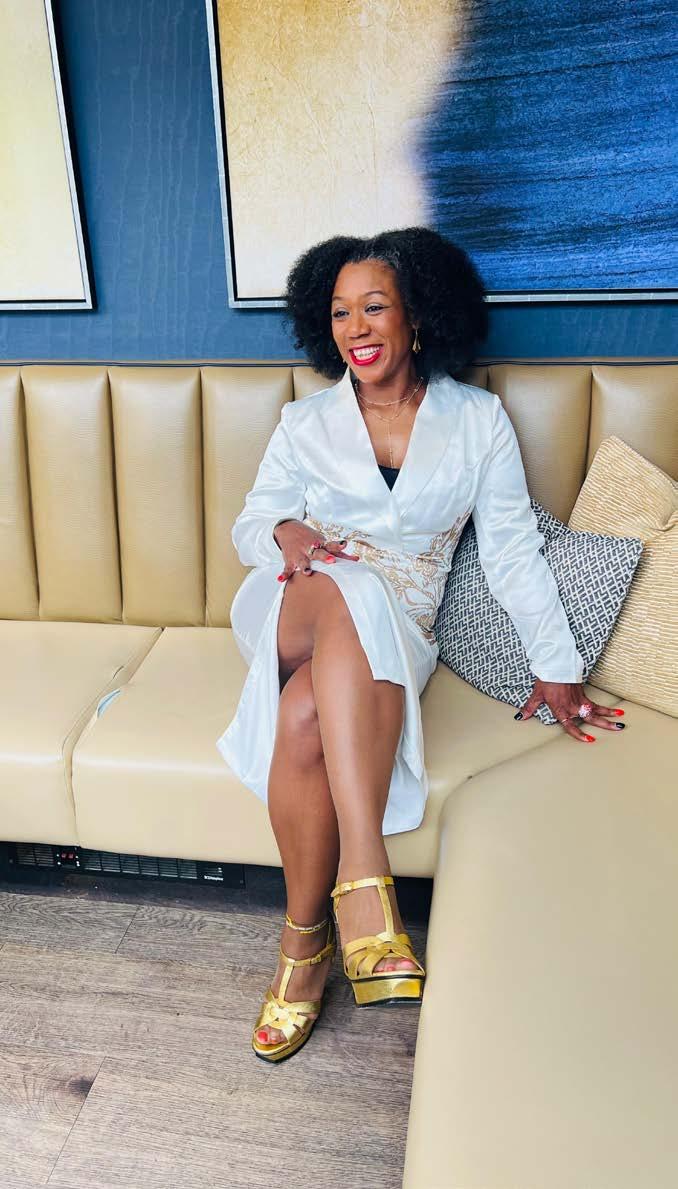
that healing looks messy. That mistakes don’t make monsters — they make humans. That the line between grace and grief is paper-thin. This is why we need X-ray vision. Not the kind that exposes others, but the kind that protects your soul from becoming cruel. The intuition. The voice of God. That sacred nudge that says, “Be kind. You don’t know the whole story.” When you’ve lived enough, hurt enough, forgiven enough, your sight sharpens — and you start to see people differently. Not by their headlines, but by their humanity.
So this week, I want to offer you this: We all have Chapter Xs. We all make the wrong turn at the worst time, and we do our best in the dark. We all carry regrets we pray never become viral content. We all have wounds that haven’t found the words yet. And that’s exactly why we need to love more — not less. If you must look at someone, let it be with your X-ray vision. The kind that sees pain under the performance.
The kind that sees trauma beneath the choices.
The kind that says, “If I had lived their life, I may have made the same decision.”
So here’s my gentle reminder, to you and to me: See clearly. Love deeply. Judge slowly. And let your #Unshakable truth be this: There is grace even in the unknown. There is strength in your Chapter X.
And there is light in how you choose to see.
‘See’ you next week.
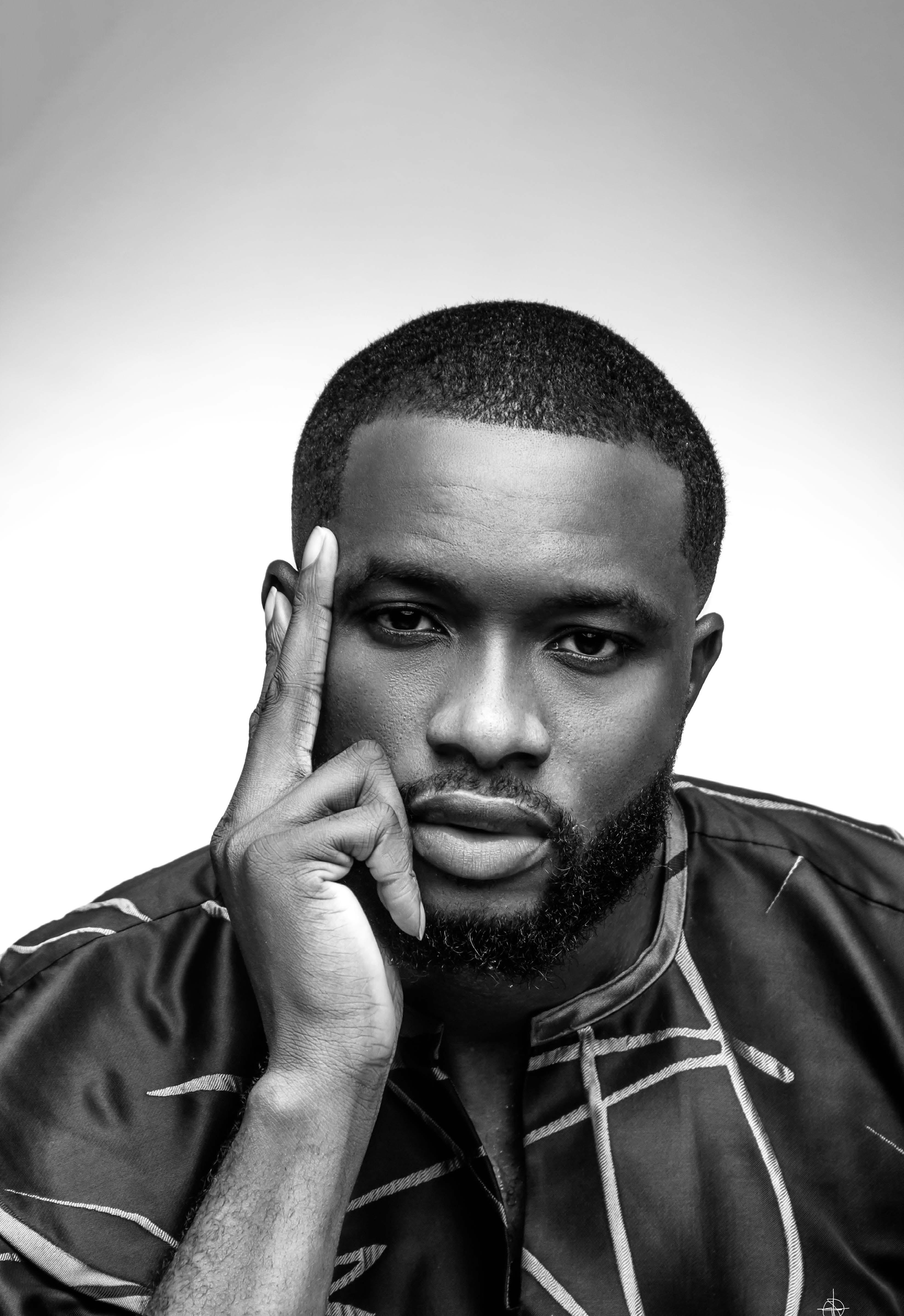
Storytelling in the Nigerian movie industry has come a long way. What started with low-budget productions has grown into a powerful force that now tells bold, real, and relatable stories. From films that entertain to those that spark deep conversations, Nollywood has become more than just an industry; it’s a mirror of our society. Through storytelling, Nigerian filmmakers are transforming the way the world perceives Africa, amplifying the voices of everyday struggles, hopes, and dreams.
One person who understands this deeply is Emmanuel Ikubese. From being crowned Mr. Nigeria in 2014 to becoming a respected actor and now a rising director, his journey has been filled with growth, purpose, and intention. While many know him for his standout role as Femi in MTV Shuga, Ikubese has gone far beyond the screen. He’s passionate about telling stories that matter, stories with depth and meaning. As a director, he’s not just creating content; he’s building impact. His directorial work, like the well-received series Kyaddala, shows his commitment to stories that spark thought and reflect reallife issues.
In this interview with THEWILL DOWNTON’s Dorcas Akintoye, Emmanuel Ikubese discusses his evolution in the film industry, what storytelling means to him, the kind of stories he wants to tell, and how he’s using his craft to build a legacy that will outlive trends and titles.
You’ve worn multiple creative hats as an actor, director, and model. Which of these roles challenges you the most and why?
Directing my own films has been more challenging because it requires me to seek out funding, build from scratch, tell my own story, and make my own films. So I would say that’s the most challenging. And I think where I’m at currently, I feel like, for me, with life, life evolves, the present state is usually your new challenge, and this is where I’m at right now as a director and a filmmaker, trying to make films and trying to come into a market and industry that is growing in such great heights and dimensions and getting attention from the global market. So, preparing yourself to not just be a player in that industry, but someone who also shapes what that industry looks like in the next five to ten years, requires quite a lot of work. And that’s where I’m at, and that’s what I’m currently doing, building and trying to prepare myself for that journey. So I would say that’s the most challenging. Has there ever been a time you questioned if you were on the right path? What pulled you back in? I feel like we often reach this point, wondering, ‘Are we on the right path?’ Are we doing the right thing? A lot of times, when things feel like they’re not moving at the pace that you want them to move, every one of us has those moments where we begin to doubt. But for me, my faith in God is what comes into play a lot of times. The things that I do, I do them because I believe I have been called to do them. And a lot of times, I realise that the fact that you’ve been called to do something does not mean you’re not going to get resistance. It does not mean you’re not going to fail. In fact, the fact that you’re called into something and the amount of resistance that you feel shows that that’s the place you need to keep on pushing and keep on striving and keep on bringing your best, and you’ll break through at some point. And I’ve also been in some experiences that I’ve seen personally in my life, the more there’s challenges, the more it helps push me to the best of my ability, to becoming the best person that I need to be, to prepare me to become that person that I need to be in regards to what I want to truly do in the industry. And that’s what I’ve seen challenges, resistance and failures do to me. It has only made me better. It has only made me stronger. It has made me more rugged. The more notes I get, the more I keep on striving to get that because I know it really takes one year.
“Even
What’s one major mindset shift you’ve had to embrace in order to grow, both personally and professionally? I would say my mindset shift is never give up. Never give up. Never give up. At the moment you feel down, at the moment it feels like it’s not working, at the moment where it feels like you’re hitting a wall, at the moment where it feels like nothing seems to be happening, the doors do not seem to be opening, just keep on going. Get back up. At the time when you feel like you’re flat down and you don’t even have the strength to try again, well, it’s okay, get back up, and just try again, right? And for me, that is my drive. Keep on going. And one scripture that helps me a lot is when the bible said all things work together for my good. So even
in the disappointments, even in the yeses and the nos, even the good and the bad times, I know that everything’s working out. So, when it seems like I have a lot more disappointments than I’m experiencing the kind of breakthroughs or the kind of yeses or the kind of advancement that I want to see, I hold on to that. Never give up because even in this disappointment, it is shaping me, or it is working together for my good. So that keeps me going. I just keep on praying for strength, and I find strength to go again, to go again, to go again. So, yeah, never give up.
What kind of stories do you find yourself naturally drawn to, both as an actor and as a director?
I love very beautifully told, compelling, emotional stories. I love stories that spark emotions and also stories that engage and stir conversations. So, a lot of the time, I’m very big on making films that are around themes or subject matters that affect us in our society that we seem not to be talking about. I seem to be very passionate about things like that, telling those stories. And I love to tell them in such emotional ways, so I put in a lot of work in regards to research to see that my stories and the characters that I build around the stories are very relatable characters to what people are dealing with, so that when people get to see this project and see these films, they see themselves in these films. And I think because that was where I came up from with my first films as an actor with MTV Shuga. It was very relatable to what a lot of young people were dealing with at the time. So, coming out of that space into my own project, I’ve found myself wanting to tell stories that are relatable to what people feel. I want to evoke genuine emotions from what people feel, so they can connect with it and see themselves in it. For example, you can see the endgame of a journey you’re on, and you’ll be like, you know what, if I see that, I will trace myself back because if that’s the endgame, I really want to get to that end. And conversations like, oh, can we really talk about this thing, themes or storylines that stir up conversations among family members, among friends, that just feel like, wow, my friend might be dealing with this, and I probably have not given them the kind of support as a friend that I need to. And we begin to find people having this conversation. So, for me, those are the kind of stories that I love to tell. Stories that create a spark or that stir up interest in people stir up a conversation amongst people.
though I am just starting, I feel like everyone always has an end game in mind from the start. And for me, if you ask me what legacy is, I want to be known as a producer and filmmaker who tells really brilliant stories. Someone who people can say, “Wow, your stories helped me make the right decision. Your stories changed my life. Your stories impacted me.”
“But for me, my faith in God is what comes into play a lot of times. The things that I do, I do them because I believe I have been called to do them. And a lot of times, I realise that the fact that you’ve been called to do something does not mean you’re not going to get resistance. It does not mean you’re not going to fail. ”
you know what, I need to take a chill pill, right, or I need to reevaluate my life, I need to reevaluate my decisions because I see myself on this path and I’m seeing the end game. So, stuff like that. So, I love to play real characters like that. I like to play characters that are just very basic. I love very challenging characters. As I mentioned, that have a lot of depth, featuring many relatable characters who carry a lot of emotional weight, which can draw the audience into the storyline.
If you could reshape the Nigerian film industry from scratch, what would you do differently to support emerging talents?
I believe it’s essential to provide opportunities that are open, free, and fair, allowing people to come in and create opportunities to generate great talent, including new talent that doesn’t have a large following. I feel like we’re slowly going to that place. There’s nothing wrong with that, as long as the person is very talented as an actor. But sometimes I’ve realised that it’s about the number. We have the likes of Mr. Macaroni, who we see as a great actor, and yes, he is a content creator. But there are a few of them. But we need to be careful not to go into that area where it’s just about likes and just about people with those huge followings and not about the talent. There’s so many kinds of people and we need to create an open playing field for them to be able to find expression and show the world their talent without feeling like they need to know someone, without feeling like they need to beg for it, they need to belong to a clique, they need to belong to a circle or they need to, in some cases, be oppressed by film producers to sleep with or whatever, private way to get a chance or to get an opportunity to showcase their talent. So, yeah, I feel giving people a free and fair playing chance to showcase their talent openly would be something that I would give a chance. And find a way to mix them up with already buzzing talent, so you can have an opportunity where we’re creating great talent. And I’m seeing people live their dreams as well.
What legacy are you hoping to leave behind, not just in Nollywood but in African storytelling as a whole?
What draws you to a script or project as an actor, what has to be there before you say “yes”?
For me, as an actor, what draws me to a project is depth. I’m very big on depth. Stories that have a lot of depth. Stories that make people feel, that make people react, that make people think, that make people reflect, that make people do an audit on their own lives and be like, okay,
Even though I am just starting, I feel like everyone always has an end game in mind from the start. And for me, if you ask me what legacy is, I want to be known as a producer and filmmaker who tells really brilliant stories. Someone who people can say, “Wow, your stories helped me make the right decision. Your stories changed my life. Your stories impacted me. Your stories gave me a chance to believe again, gave me a chance to pick myself up again.” Globally or from an African context, I want to be able to tell stories that shape who we are as Africans, that change the narrative on how we see ourselves and how the world sees us. I want to be known for excellence, to be a filmmaker and leave a legacy that says, “Wow, whatever project Emmanuel does is excellent.” There are a lot of details he puts into it. He’s a master at what he does. From the story to the film, from pre-production to post-production to building characters to every aspect of the film, people can see that there’s so much that he has put into work. And also, I want to be known for giving emerging talent an opportunity to come into the limelight,

into the industry and showcase themselves and showcase their talents. I also want to be known for one who has trained a lot of people. That’s what I thought, you know, it doesn’t seem like, apart from just giving actors an opportunity, opportunities to actors, to train them, not just actors, to filmmakers, to help them find their own calling as individuals on their own lane. I want to be known as a positive role model, someone people can look up to, a generation can look up to, and say, “You know what, Emmanuel is doing it right.” He’s level-headed. He seems to know what he wants. His lifestyle, his character is very positive. He’s full of light. And, you know, he’s known to be respectful. And he’s a good person, right. I want people to see Christ. I just want people to see, at the end of the day, that this is a role model that a generation can look up to and see that he is someone who is levelheaded and has worked with so much excellence. I want to be able to push the narrative, push to such heights and such levels that has never been achieved before, even globally, for an industry like what we have in Nigeria and Africa at large and find ways to connect the continents through stories.
What’s one dream project you haven’t done yet but are actively working toward, maybe something that scares and excites you at the same time?
There are so many. I’ve not even started yet. I think there’s so much
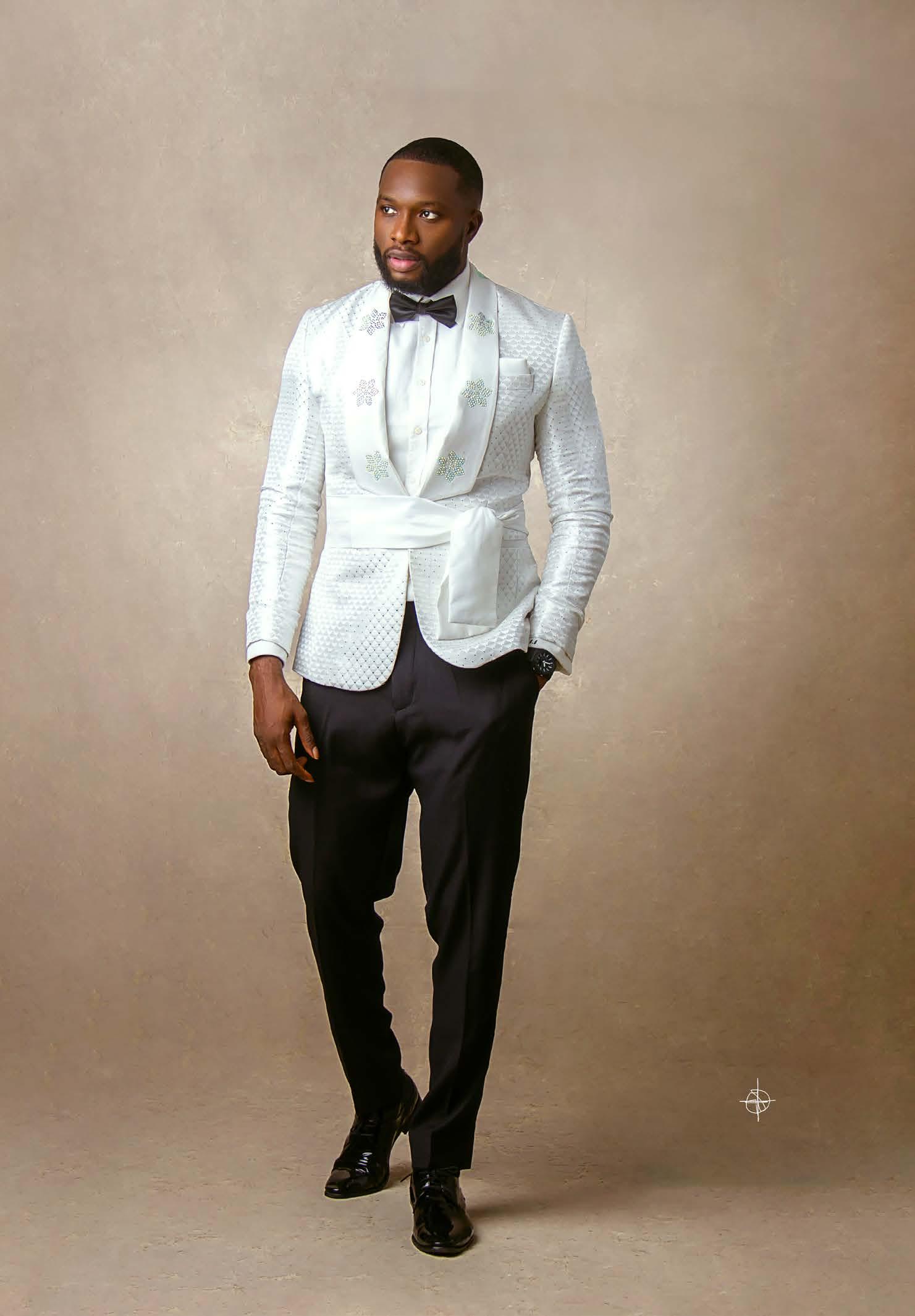
I have. A lot of the projects that I have are very scary projects because they don’t seem to be in a status quo of what we do at Nollywood as an industry, which is very scary. So, I find myself trying to expose myself to people with such level of excellence so that I’m able to bring such projects to life. A lot of them I’m learning on the go. I’m still developing myself and my skills to bring projects like this to life. But I have a lot. I can tell you that 95% of the projects that I have are beyond just the norm.
How do you stay grounded in your purpose while navigating fame, pressure, and the ever-evolving entertainment industry? To give you a response from the standpoint of what the industry is, I spend a lot of time within. One of the things I have learned so much is learning to build in silence. And I’ve realised that in silence is where a lot of things happen
for you. You’re not so much in the noise. There’s so much happening in the noise, and the noise can be very distracting sometimes. But in silence is where you can build, where you can find solace, where you can find peace, where you can build, and then come out, do what you need to do, and go back into that space. So, I tell you, that’s the one thing I’ve found in this season, and it’s something I intend to keep. Yes, I come out when I need to and do the things that I need to do. But most importantly, I have learned to know when to withdraw into my shell and build in that space. So, for me, it is walking in silence.

BY JOHNSON CHUKWUEKE
Close your eyes. Imagine stepping into a breezy beach villa, coconut trees swaying, warm air filled with hints of citrus, vanilla, and sea salt. Now open your eyes. You’re actually in your Lagos apartment, but who says your space can’t smell like a five-star tropical escape? Scent is the most powerful sense tied to memory and emotion. Just one whiff can transport you to a sunny getaway, even when you’re stuck indoors dodging deadlines or Lagos traffic. Home fragrance is more than just a nice touch; it’s mood-lifting magic. And with the right mix of scents and styling, your home can feel like a permanent vacation. Ready to turn your space into a tropical dream? Here are five ways to make your home smell like a lush island hideaway.


While candles set the mood, reed diffusers provide a constant scent without the need for a flame. Try blends like coconut-lime, pineapple-mint, or mangopapaya to give your home that sun-soaked vibe 24/7.

Freshen Fabrics With Linen Mists
Spritz your sheets, curtains, and throw pillows with linen sprays in beachy scents like sea breeze, coconut water, or tropical orchid. It’s the fastest way to make your room feel freshly turned down by a resort staff.

Add tropical essential oils, such as ylang-ylang, bergamot, and sweet orange, to a diffuser. A bonus is that these oils not only smell amazing, but they also promote calmness and clarity. Think of it as a spa retreat for your senses.

Get creative with bowls of dried citrus slices, hibiscus petals, cinnamon sticks, and vanilla pods. Not only do they smell divine, they also double as earthy-chic décor accents for your coffee or dining table.

Fresh flowers, such as frangipani, gardenia, or hibiscus, not only brighten up a room but also fill it with a natural aroma. If you can’t find tropical flowers locally, try greenery with light, refreshing scents, such as eucalyptus or lemongrass. Let Nature In
Creating a fragrant home isn’t just about making it smell good; it’s about crafting an experience. When your space smells like a tropical retreat, it encourages you to slow down, breathe deeply, and enjoy the moment. It’s a subtle but powerful form of self-care that turns your living room into a feel-good sanctuary. You don’t need a plane ticket to escape; just a little creativity, the right scent blends, and a sprinkle of imagination. So go ahead, light that mango candle, spritz that linen mist, and let your home transport you to somewhere blissfully breezy—even if you’re just in your pyjamas binge-watching Netflix.
BY DORCAS AKINTOYE
Most people use lotion or moisturiser to keep their skin hydrated and soft. But what happens if you want to try something new or your usual product runs out? Instead of using conventional lotions, there are other safe, natural ways to maintain hydrated, bright skin. Whether you’re dealing with dry patches, dryness, or simply want a simpler skincare routine, this article will show you five easy-to-find and affordable alternatives that work just as well, if not better, than store-bought moisturisers.
One of the most widely used natural moisturisers is coconut oil. It contains a high amount of fatty acids, which help keep your skin hydrated and smooth. Additionally, it possesses antibacterial and anti-inflammatory properties that may help manage skin conditions such as eczema or irritation. To use it, scoop a small amount into your palm, rub it between your hands, and massage it gently into your skin. It melts easily and absorbs well. Just be careful not to use too much, as it can feel greasy if applied too heavily. Use it immediately after a bath or shower, when your skin is still damp, for optimal results.


Shea butter is thick and creamy. It has vitamins A and E that help fix dry and damaged skin. When applied to your skin, it creates a protective layer that retains moisture. This makes it ideal for individuals with very dry skin or during periods of dry weather. To use it, warm a small amount between your fingers until it melts, then rub it on your skin. It works best on rough areas, such as your elbows, knees, and feet. To make it easier to spread, you can mix it with coconut oil or olive oil.


Olive oil isn’t just for cooking; it’s also great for your skin. It contains healthy fats and antioxidants that keep your skin soft and glowing. It’s perfect for people with dry or ageing skin. To use it, pour a small amount onto your palm and rub it into your skin just like lotion. It works best when applied after bathing. For extra moisture, you can add a few drops to your bathwater.
Serums are thin liquids that are good for your skin. They have special ingredients like hyaluronic acid, vitamin C, or niacinamide that help your skin. Unlike thick creams, serums penetrate your skin quickly and provide it with deep moisture. After washing your face, apply a few drops of serum. Then add a protective oil or butter, like shea butter or Vaseline, on top. You can use serums every day. They’re perfect if your skin is dry, dull, or has fine lines.

Petroleum jelly is a simple and effective way to lock in moisture. It doesn’t add moisture to your skin, but it seals in the moisture that is already there. That’s why it’s best used after bathing when your skin is still damp. It’s perfect for dry hands, cracked heels, and chapped lips. A little goes a long way, so start with a small amount. If you don’t like the greasy feeling, apply it at night before bed and let it work while you sleep.

You don’t always need fancy lotions to keep your skin healthy and moisturised. Natural and simple products, such as coconut oil, shea butter, and serum, can work just as well, and sometimes even better. Plus, they’re usually more affordable and contain fewer chemicals.


You don’t have to run a marathon to feel better. A 10-minute walk, a living-room stretch, or a quick dance to your favourite throwback jam can help shake off that sluggish energy and get your blood and your mood flowing. Get Moving, Even Just a Bit

Create a Comfort Corner
Build a small sanctuary, a candle-lit spot with soft music, a book, and zero notifications. Even 15 minutes in this zone can feel like a mini reset—no screens, no chaos, just calm.
BY JOHNSON CHUKWUEKE
Some days feel heavy. The sky is dull, and your mood follows suit; everything feels like it’s moving in slow motion. Whether it’s rainy weather, life stress, or one of those “blah” days, it happens to everyone. But the good news? You don’t have to stay stuck in that grey-cloud headspace. With the right habits, you can lift your spirits—no sunshine required. Grey-sky days call for a different kind of self-care. You might not be dancing around your room in excitement, but you can still choose small joys that nudge your mood in a better direction. It’s less about doing something dramatic and more about stacking little habits that feed your soul.

Nourish With Feel-Good Foods
Some meals feel like hugs from the inside. Think warm soups, herbal teas, grilled plantains, or even jollof rice with a side of roasted veggies. Eating foods that nourish, rather than fill, can make a significant difference in how you feel.

Check In With a Friend
There’s nothing like a voice note from a loved one to remind you you’re not alone. Reach out. Share a meme. Say hi. Even if you’re not up for a full chat, that little connection can give your day the boost it needs.

Try not to view grey days as “bad.” Instead, think of them as nature’s reminder to slow down. Grey skies invite rest, reflection, and a sense of softness. Cosy up with a blanket, journal, or podcast, and lean into the mood instead of fighting it.
Grey-sky days may feel dull, but they hold their own kind of beauty, especially when you meet them with gentle habits that care for your mind and body. From a nourishing meal to a meaningful message from a friend, the smallest rituals can create the biggest shifts. So next time the weather or your mood is feeling low, don’t reach for the panic button. Reach for your playlist, your comfort food, your journal, or even your yoga mat. A brighter day doesn’t always come from the sun. Sometimes, it starts with you choosing to be kind to yourself.

How did you land the role of lead stylist for To Kill A Monkey? Was it different from other projects you’ve worked on?
Landing the role of lead stylist for To Kill
A Monkey was truly a mix of preparation, reputation, and the right timing. I got the role through my ongoing working relationship with Kemi Adetiba. We had worked together on a few projects in the past, including music videos and King of Boys, so there was already that creative trust and understanding between us.
What made this one different, though, was the emotional intensity and layered storytelling of the film. Every look had to reflect not just the character’s personality but also their emotional state in very specific moments.
While styling the major characters, Oboz, Efe and Teacher, I had the creative freedom to shape how each character was interpreted through their wardrobe. I worked closely with Kemi and Remi to align my interpretation of the styling with the film’s overall vision.
The film seems intense and layered—how did you reflect those emotions through your costume choices?
The film is really intense and layered, so I knew the costumes couldn’t just be surfacelevel. I had to dig deeper and ensure that every look captured the emotions the characters were experiencing. It was more than just dressing them; it was about using fashion to mirror their journey. From the fabrics to the cuts, even how their looks evolved throughout the film, everything was intentional. The clothes had to feel like a silent extension of their story.
Did the director or actors give you any specific styling input, or did you have full creative control?
There was definitely collaboration, especially with the director, Kemi Adetiba, and the producer, Remi, but I was given a lot of creative freedom, which I really appreciated. Kemi has a strong visual language, so she was
In the fast-paced, visually driven world of Nollywood, where image meets impact, few names resonate as loudly in the styling world as John J. Angel, better known as De Angelic Touch. With a career spanning over a decade and encompassing numerous music videos, red-carpet moments, editorial shoots, and cinematic projects, John has built a reputation as one of the most sought-after and highest-paid stylists in Nigeria. But his latest work, bringing life to the wardrobe in the highly rated Netflix original To Kill A Monkey, might just be his most audacious yet.
Known for his fearless approach to fashion and his ability to merge authenticity with high-end aesthetics, John’s influence on the screen is undeniable. In To Kill A Monkey, a gritty, cybercrime-themed drama, he transforms characters through costume, painting their stories not just with dialogue, but through fabrics, textures, and silhouettes that speak volumes.
Beyond his sharp eye for style, John is also a seasoned makeup artist, creative consultant, and intuitive collaborator with some of Africa’s biggest music and movie stars, including Wizkid, Davido, and others. Yet, behind the glitz is a man who draws inspiration from everyday life, grounded in personal values and a deep passion for visual storytelling.
In this exclusive conversation with THEWILL DOWNTOWN’s Johnson Chukwueke, the style visionary discusses his work on To Kill A Monkey, his creative journey so far, and the life behind the lens.
clear about the tone and emotional layers she wanted to see, but she trusted me to interpret that through styling.
What was the most challenging scene to style in To Kill A Monkey, and how did you overcome it?
There were a few particularly challenging scenes, especially those in which the characters underwent significant emotional shifts. Those moments required the wardrobe to convey a lot without doing too much, and striking that balance isn’t always easy. But I trusted the preparation I had done and just followed the feeling of the scene. Sometimes you have to go with your instinct and not overthink it.
There’s been a lot of buzz about the fashion in the film. Which character’s style are you most proud of and why? I’d say I’m most proud of Oboz and Teacher. With Oboz, his look had to be bold and flashy, yet still carry the weight of someone trying to prove something; there was a loudness and a vulnerability of money miss road there. Teacher, on the other hand, was more controlled and intimidating in a quiet way, so his style had to reflect that power. Both were very different, but each look told its own story, and that’s what I love most about styling.
If viewers look closely, are there any hidden meanings in the costumes you styled?
With Teacher, I wanted to channel that unmistakable Port Harcourt kingpin energy, the kind of man who moves like an area godfather. He’s feared, respected, and always calculated, but never loud. So I styled
him with a vintage swagger: the papa’s cap, the pipe, it all gave him that old school, streetrooted authority. He’s the kind of character who doesn’t need to say much; his presence and his style say it all.
With Oboz, it was fun to style because he’s that loud, proud Benin boy, very money miss road, the kind of guy who thinks he’s the best dressed in every room, even when he’s doing the absolute most. I played into that with bold colours, flashy accessories, and pieces that scream for attention. He’s stylish in his head, and that confidence, even if it’s misplaced, is what makes his look so entertaining and believable. And that contributed to the character of Oboz.
Everything about his wardrobe was meant to reflect someone who’s trying really hard to prove he’s made it.
From music videos to movies, how do you adapt your styling approach for different formats?
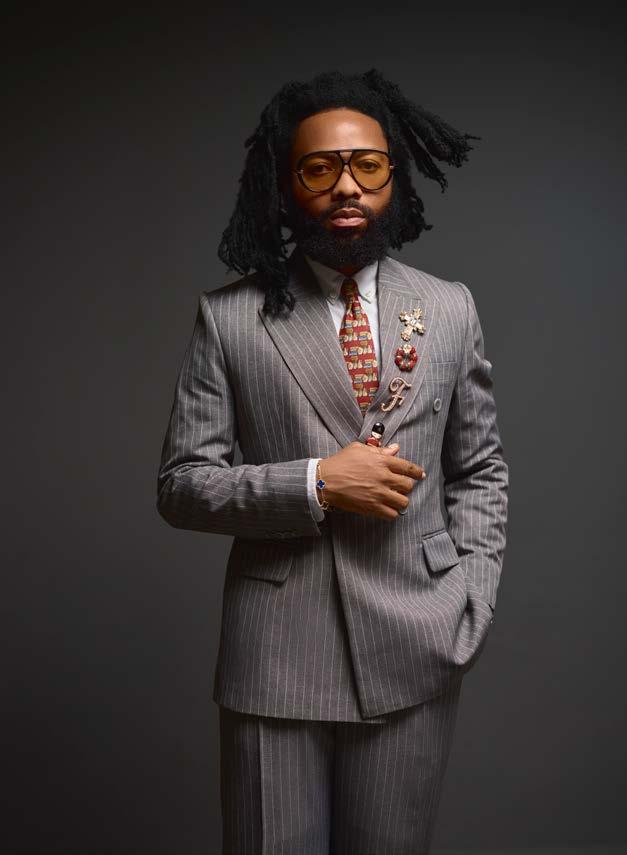
I actually started costuming Nollywood movies way back around 2005, 2007, but I stepped away from it for a while and focused more on other parts of the industry, like fashion and music videos. Coming back into film was through Kemi Adetiba with King of Boys, and I think she just understood that I know how to interpret characters through styling. With music videos, it’s all about the visuals, making bold statements quickly, and a bit of storytelling, too. But with film, you have to slow down and be more intentional. Every look needs to reflect a character’s journey, not just look good on screen. I approach each format differently, but what remains constant is my attention to detail and my ability to interpret a character through styling.
What’s one thing fans would be surprised to know about you outside of fashion and styling?
I’m a very good cook. No worry I dey cook wella.


Ilive alone. It’s one of the things I love most about my life, my space, my silence, my freedom. My mum hardly visits, and even when she does, she always calls first. She thinks her daughter is a calm, responsible working-class girl just trying to survive Lagos. But if she knew half the things I do when I close my door, I doubt she’d call me her daughter again. That Saturday, I was in one of those moods. You know that feeling when your body is hot, restless, and aching for something you can’t scratch away? I was horny. Badly. I didn’t plan for anything to happen; I didn’t even have anyone in mind. Then Tobi texted.
He wasn’t my boyfriend. Just a fine guy I’d known for a while. Cool, funny, a bit of a flirt. We’d never done anything before, but we had chemistry. I told him to come over. The house was quiet. I was in oversized shorts and a tank top, bare-faced and barefoot.
When he arrived, we sat in my living room talking about random things: music, relationships. I laughed more than I should have. I kept looking at his lips without realising it. And the way he looked at me, like he was undressing me with his eyes, didn’t help either.
At one point, I got up to get water, and he followed me to the kitchen. I turned around, and we were
suddenly too close.
The air changed.
I don’t know what came over me, but I leaned in and kissed him. He didn’t hesitate. He kissed me back like he’d been waiting for that moment. His hands moved to my waist, pulling me in, and his tongue slid into my mouth.
Everything became urgent.
I led him to my bedroom without saying a word. Clothes dropped one by one: his shirt, my shorts, my top. I didn’t even care where they landed. I just wanted him. I lay back on the bed, and he climbed on top of me, kissing me like he meant it. His fingers explored every part of me, slow and firm, like he was learning my body. Then he entered me.
And he felt so good.
I gasped as he started to move, slow at first, teasing. Then deeper. Harder. He held my hips and rocked into me, his lips on my neck, whispering my name. I wasn’t even trying to hold back. I moaned freely, biting my lip, gripping his back. The bed creaked, my legs shook, and my body melted into his.
I didn’t know Tobi had it in him. He touched places I didn’t know were touchable. I kept moaning, begging him not to stop.
Then I heard my name.
“Ifeoluwa”
It was faint. Like it came from far away. My body froze, but he was still moving inside me. Then I heard it again, louder this time.
“Ifeoluwa!”
That voice. I knew that voice.
My eyes shot open. I turned my head toward the door, and there she was.
My mother.
Standing in the doorway. Staring at me. At us. Her mouth hung open slightly, like she couldn’t believe what she was seeing.
Tobi was still in me. We were both naked. I could feel his heartbeat against mine.
I couldn’t speak. My mouth opened, but no words came out. Shame crawled all over my skin.
My mum said nothing. She just blinked slowly, shut the door quietly, and left.
Tobi slowly pulled out of me, both of us still breathing hard. The room that had just been filled with moans and heat was now silent, awkward, exposed, too bright.
“I think I should go,” he said.
I nodded. I couldn’t even look at him.
After he left, I reached for the blanket, covering myself, eyes still fixed on the door like it might swing open again.
My mum has never caught me in that vulnerable position, but it is what it is.
The awkward talk with my mum came much later that night. I won’t lie, it was uncomfortable. She was hurt, disappointed, maybe even betrayed, because that was the real me. Not the perfect daughter.
BY BOLUWATIFE ADESINA

Howdo you make a legacy sequel when you’re unsure what your legacy even is? That’s the question plaguing I Know What You Did Last Summer, director Jennifer Kaytin Robinson’s update of the 1997 slasher of the same name. Stuffed to the gills with thudding callbacks, hoary one-liners, and phoned-in cameos, the film feels like the predictable endpoint of a trend toward empty nostalgia that’s run through all the big fish in horror cinema and is now coming to swallow up whatever might be left behind.
After the events of the summer that still haunt Julie James (Jennifer Love Hewitt) and Ray Bronson (Freddie Prinze Jr.), the North Carolina fishing village of Southport suffered an economic downturn, giving land developer Grant Spencer (Billy Campell) an opportunity to turn it into the “Hamptons of the South.” Among Southport’s new generation of rich young people is Ava (Chase Sui Wonders), who comes back from college to celebrate the engagement of her bestie, Danica (Madelyn Cline), to Grant’s son, Teddy (Tyriq Withers). Also in attendance are Milo (Jonah Hauer-King), who still carries a torch for Ava, and Stevie (Sarah Pidgeon), who, following a traumatic event involving Ava’s father, now stands outside this inner circle.
When the group go joyriding to catch some Fourth of July fireworks, they inadvertently kill a motorist and lean on Teddy’s father’s connections to cover up the crime. But, wouldn’t you know it, the past refuses to stay buried, and the following summer the appearance of a familiar fisherman armed with a hook drives the film’s central fivesome to seek the help of the only survivors of the slickerwearing maniac’s previous reign of terror.
It goes without saying that Scream rewrote the book on what horror
cinema was and could be in the 1990s, bringing a metareferential freshness that delighted an audience who was more literate about the genre’s tropes than ever before.
The original I Know What You Did Last Summer is considered derivative of Scream, but Kevin Williamson wrote the former before the latter, and it was Scream’s monster success that got I Know What You Did Last Summer greenlit
As a script based on the 1973 young adult novel by Lois Duncan, the 1990’s I Know What You Did Last Summer, despite some snappy dialogue in its opening sections, feels like a much more oldschool whodunnit than the film whose success it’s often accused of coasting on.
This is ironic, as Robinson’s take on the material is shamefully imitative of what has been done with the 2020s Scream sequels and what David Gordon Green did with his new Halloween trilogy. In short, this new I Know What You Did Last Summer is truly a copy of a copy.
As for the original film’s legacy, that’s pretty nebulous. It never had the personality of Scream, and its inessential follow-up, I Still Know What You Did Last Summer, ensured that the series wouldn’t have the legs either. What the first film did have, though, was a quartet of the hottest talent at the time, and a sense of place. There’s a ghost of a good idea in bits and pieces of the plot, and the climax raises questions about the erasing of legacy within the text, but it’s neither smart nor insightful enough to note how the same faceless corporatisation of the town at its centre is eating the movie alive from the inside out.
The film consistently overestimates our investment in the older characters while failing to give us new ones worth caring about. Even worse, there are attempts to mimic the rhythmic snap of Williamson’s dialogue, but Robinson and co-writer Sam Lansky lean too hard on the mannerisms of chronically online Gen-zers, which hit the ear wrong and date the film even as it unspools before us. Most unforgivable of all, though, is that there are no great kill sequences.
Late in this reboot, a character states, “Nostalgia is overrated,” and it feels like an indictment of the film we’ve been watching. Far from making a case for the original I Know What You Did Last Summer as one with its own identity and a legacy worth turning over, Robinson’s update is so cynically made and self-indulgent that it will at least leave you respecting the workmanlike scare-making that director Jim Gillespie brought to the 1997 film.
Rating:4/10
Stop. The. Remakes.

Scan this with your camera or click to access the playlist (Youtube Music)

Scan this with your camera or click to access the playlist (Spotify)
Let’s get the obvious out of the way.
Untamed is a miniseries starring Australian Eric Bana and New Zealander Sam Neill, but they are playing Americans in a story set in Yosemite National Park. However, the show was actually filmed in Canada.
There’s a bit of dissonance there, but you’ll get over it quickly. Streaming shows are increasingly engineered to open with a punch (they don’t want you clicking away after 40 seconds), and Untamed starts with a banger.
Two abseilers are hanging off a rock face when a body from above plummets towards them. It gets caught up in the ropes that connect the two, and the velocity and weight of the body pulls on their anchors. The body threatens to drag the abseilers to their deaths.
Despite the dramatic opening, Untamed is often a more patient show, until it’s really not. The body is that of a young woman named Lucy, and she has injuries that suggest her death is far from the suicide some park officers want to believe. A sceptic is Kyle Turner (Bana), a senior investigator for the National Parks Service.
Kyle, newbie Naya (Lily Santiago) wants to do things the hard way. He’s a rugged, laconic kind of guy. Naya learns pretty early on that Kyle and his ex-wife Jill (Rosemarie DeWitt) suffered a great tragedy when their young son was abducted in the park, and his body later found. The park is full of secrets and dangers, and Lucy’s death is connected to her history in it, a past that triggers questions about other open cases.

Everyone has a story that is slowly revealed – Naya, and why she moved to the park service from Los Angeles with her young son; gun-toting hunter Shane (Wilson Bethel), for whom Kyle has a particular dislike; and Kyle’s boss Paul (Neill).
The title, Untamed, should, in theory, refer to the wildness of Yosemite (and the Canadian landscapes, standing in for California, are stunning and greatly elevates the series’ look), but, obviously, the real dangers are men.
It’s man’s heart and soul you can’t tame or control. Whether that’s falling down secret shafts or discovering the tragic history of the victim, it’s humans that are the real threat. Bears seem easy enough to scare off with a couple of gunshots in the air. Untamed was created by Mark L. Smith and Elle Smith, and the former is also behind American Primeval,



another Netflix series that taps into the lawlessness of the American west, plus the screenplays for The Revenant,
There’s a theme here, Smith likes stories removed from the civility of cities and suburbs, where humans reveal their true natures when they’re not buttressed by modern social structures. Untamed flirts with this, even if it doesn’t have anything specifically profound to say, but at least the scenes look pretty.
The series is middling, a by-the-book murder mystery with the veneer of something distinct. But once it’s exhausted all the plot twists and revelations, you know you’ve seen it all before. It has shades of better shows such as True Detective or The Killing, but is closer to the genre’s more mediocre entries, such as The Sinner
On the plus-side, Bana is always an arresting presence on screen, and Santiago holds her own against her more experienced scene partner. Ultimately, Untamed is inoffensive. It’s fine, and it will likely be top of Netflix’s charts before the weekend. But there’s not much about it that’s memorable.





